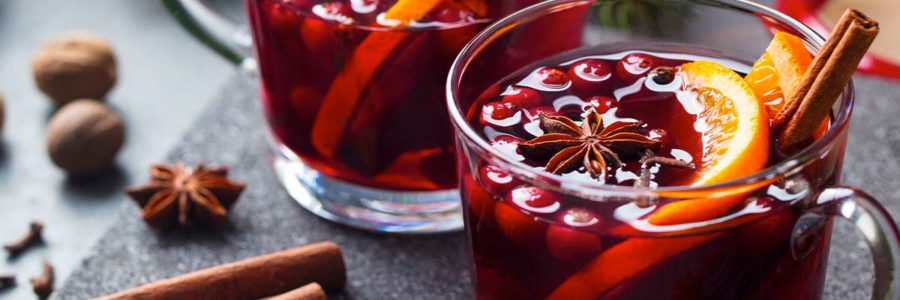Mulled Wine Recipe: Mulled wine is a Christmas classic; believe it or not, it is a fantastic healthy post-dinner beverage. Loaded with spices and aromatics, a mulled wine can help you digest and relax after a big meal. Read on for the ultimate healthy mulled wine recipe!
Opting for a Natural Non-Toxic Wine
Mulled wine calls for wine, and as the more prominent ingredient in the recipe, it’s important to opt for a high-quality, natural, and non-toxic wine. Conventional wine is made with grapes that are sprayed with pesticides and herbicides. The residue of these pesticides is then fermented along with the grapes and, when consumed, will add to your toxic load. Even organic wines in many parts of America test for the residue of dangerous chemicals like glyphosate because of run-off and how present it is in the tap water system 1.
Some wine companies are not only organic but lab-test their wines for purity. Whether you’re making mulled wine or drinking wine as is, Dry Farm Wines makes keto and paleo-friendly dry wines that are also sugar-free.
Alcohol is arguably the sticking point for many people regarding the health benefits of wine. Mulled wine, however, reduces the alcohol content significantly. Fifteen minutes of simmering reduced the alcohol content by 40%. If you want to reduce it, even more, an hour of simmering will reduce it to 25% of its original alcohol content.
Aromatic Spices and Bitters
The abundance of aromatic spices and bitters makes mulled wine not only delicious but also nutritious. Although wine itself has many anti-aging benefits, the added ingredients to a mulled wine improve digestion, lower cortisol levels, and reduce stress.
Cinnamon contains antioxidant, anti-inflammatory, metabolism-booking, and glucose-regulating properties. Using cinnamon is a great way to balance blood sugar levels, which are already low in a dry natural wine. Ceylon cinnamon contains more medicinal properties. 2
Clove is another antioxidant-rich spice with potent antibacterial properties, helps regulate blood sugar levels, and is rich in manganese. 3
Star Anise promotes digestion and has potent antibacterial and fungal properties. It is also rich in flavonoids and polyphenols, including linalool, quercetin, anethole, shikimic acid, gallic acid, and limonene. 4
Oranges are loaded with vitamin C, but the biggest benefits come from the oils found in the rind. These oils have antimicrobial, pain relief, weight loss, and antioxidant properties. The orange peel also provides a digestive boost. 5
Ginger is well known for its digestive-boosting properties and also loaded with antioxidants that prevent stress damage. It helps a variety of ailments, including heart disease, high blood pressure, and viral infections. 6
These are just some wonderful, warming, and medicinal ingredients in the mulled wine recipe below.
When choosing your spices, it’s typically best to stick with whole or crushed spices. Although the ground flavor is much more aromatic and potent, they are very difficult to strain out. Avoid the finely ground spices unless you want to sift your mulled wine through a cheesecloth.
With whole or crushed spices, you can also leave them in the pot and just use a ladle to serve the mulled wine to family and friends when they come over!
Mulled Wine Recipe

Ingredients
- 1 750ml bottle of natural organic red wine
- 1 orange
- 10 dried cranberries (with no added sugar)
- 1 tablespoon of sliced fresh ginger
- 3 cinnamon sticks
- 4 whole cloves
- 2-star anise
- 5 allspice berries
- Maple syrup to taste (optional) about 1-3 tablespoons
- Garnish with a slice of dried orange (optional)
Instructions
- Bring all the ingredients except for the maple syrup to a boil and immediately reduce to a low simmer.
- Simmer for 10-15 minutes (or to the desired alcohol content)
- Strain the spices and whisk in the maple syrup to taste if you would like it sweeter
- Garnish with a slice of dried orange
References
1 “Organic Research.” The Dirt Doctor, https://www.texasorganicresearchcenter.org/organic-research-page/Glyphosate-found-In-100-Of-California-Wines-Tested-Even-Some-Labeled-Organic_vq12656.htm.
2 Rao, Pasupuleti Visweswara, and Siew Hua Gan. “Cinnamon: a multifaceted medicinal plant.” Evidence-based complementary and alternative medicine : eCAM vol. 2014 (2014): 642942. doi:10.1155/2014/642942
3 Ali, Shakir et al. “Eugenol-rich Fraction of Syzygium aromaticum (Clove) Reverses Biochemical and Histopathological Changes in Liver Cirrhosis and Inhibits Hepatic Cell Proliferation.” Journal of cancer prevention vol. 19,4 (2014): 288-300. doi:10.15430/JCP.2014.19.4.288
4 Miyagawa, Michiyo et al. “Anxiolytic-like effect of Illicium verum fruit oil, trans-anethole and related compounds in mice.” Phytotherapy research : PTR vol. 28,11 (2014): 1710-2. doi:10.1002/ptr.5190
5 Seladi-Schulman, Jill. “Orange Essential Oil Uses, Benefits, and Safety.” Healthline, Healthline Media, 3 Oct. 2019, https://www.healthline.com/health/orange-essential-oil-uses#benefits.
6 Wang, Shaopeng et al. “Biological properties of 6-gingerol: a brief review.” Natural product communications vol. 9,7 (2014): 1027-30.


